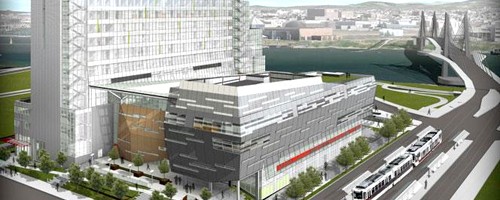The groundbreaking ceremony for the new Life Sciences Building on Oct. 12 marked a new direction for the science department in terms of collaboration with other universities as well as a shift in Oregon’s research economy.
Set to open in August 2013, the new Life Sciences Building will be shared between Portland State University, Oregon Health and Science University and Oregon State University. Located on the South Waterfront, the new facility will house state-of-the-art laboratories and one of the largest lecture halls in the state. This transformation puts PSU in a position to collaborate with other universities and acts as a means to establish Portland as a research economy.

The current science facilities at PSU have inadequate space and resources to accommodate classes. Hoffmann Hall’s capacity of 280 students and overbooked courses have led to students sitting in the aisles on the first days of classes. The more popular science courses and labs, including three General Chemistry sections, two Organic Chemistry sections and a Principles of Biology course, are slated to move to the new site’s 500-seat lecture hall. With almost double the space, this new addition will give more students an opportunity to attend these classes.
Another advantage to the lecture hall is its utility as a space for performing demonstrations. Positioned above the students, the stage in Hoffmann Hall isn’t adequately designed for these kinds of lectures. Students, especially in the front rows, must crank their necks to look up at their professors, making even the most basic demonstrations difficult to show in the classroom. The new lecture hall is designed with these accommodations in mind.
The Life Sciences Building represents remarkable advances in collaboration as well. The new building will have shared research labs with OHSU and OSU that will be by discipline instead of institution. This means that students will not only be working with students from other universities, but also interact with people in their desired fields. They won’t just be working around pre-doctors, pre-dentists and pre-pharmacists; they will actually be put in a position to work with people already in these professions.
Having the departments delineated by field means that the building itself is designed for collaboration. It is an integral part of the sciences that has previously been underdeveloped within the university. With federal grants and projects impressing upon interdisciplinary works, PSU, OHSU and OSU will have a building that is designed with collaboration in mind.
Dr. Niles Lehman, an associate professor of chemistry and the chemistry department chair, is excited about the development and the potential to work with other students and professionals. “You can just walk 20 feet down the hall to talk to them instead of the 28 bus,” Lehman said.
The plan is not without drawbacks. The foremost problem with this design is that students have to take a bus to get to the new facility. The Life Sciences Building will be located on the South Waterfront, so students may have to commute between the two campuses. This is going to present some interesting challenges, especially with only some of the lectures and labs moving. Not only are some of the classes moving, but the Organic Chemistry courses are going to be split between the campuses. The lectures are moving to the South Waterfront, but the labs are to remain in the new laboratories in the Science Research and Teaching Center (formerly known as Science Building 2).
This is not a new idea. Both PSU and OHSU host several campuses and follow in the footsteps of an increasing number of expanding schools. The new site has a large amount of space dedicated to bike storage, the Portland Streetcar runs through the South Waterfront and in winter 2012 the Portland-Milwaukie MAX line is set to be completed and will run through the new campus. People are optimistic that these challenges will eventually be overcome.
Despite the difficulties that the distance will create, the new campus marks an innovation for science in Portland. The hub for research in Washington is Seattle, but with the major academic foundations split between Corvallis and Eugene Oregon’s research capacity has fallen. In addition to tapping into the city’s research potential, the new Life Sciences Building creates an outlet for federal funding. Since federal grants support the biomedical field, which can only be found in Portland, this means that the transformation of research economy not only puts the Life Sciences Building as a potential for national standards, but also puts PSU at the forefront of that innovation.

